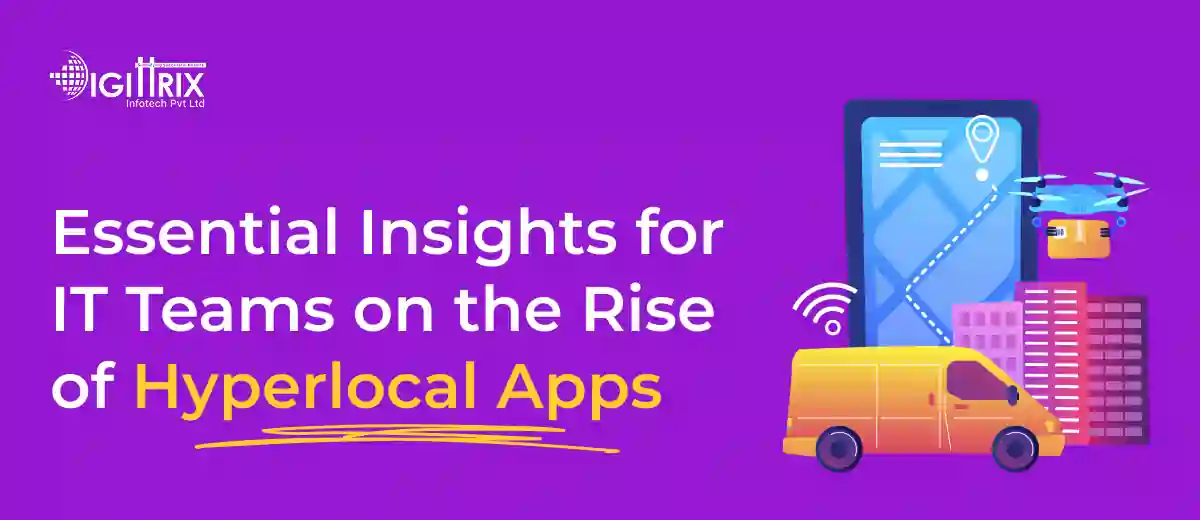Hyperlocal apps dominate local markets, linking users with nearby services through instant mobile solutions, shaping business growth and redefining convenience in everyday transactions.
Highlights
With Over 14 years of Experience in the IT Field, Helping Companies Optimise there Products for more Conversions

In recent years, mobile-based services have become a vital part of daily life. People expect to receive products, food, medicine, or other services within minutes and prefer dealing with local agents. This has led to the growth of hyperlocal app development, where apps are designed to connect local customers with nearby service providers or stores within a very small area.
For IT teams, this growth demands adapting development strategies to satisfy both user expectations and business needs. Understanding how hyperlocal apps function, the challenges they bring, and what is required to build them is crucial for anyone involved in mobile app development.
Looking to elevate your Shopify store? Explore Digittrix's comprehensive guide to custom Shopify app development and learn how you can build exclusive tools and seamless integrations for your business!
A hyperlocal app is a mobile application that serves users within a small geographic area, sometimes just a single suburb or city block. These apps connect people with businesses or individuals who can deliver products or services in that specific area. Examples include grocery delivery apps serving only one city, laundry pickup services in a particular suburb, or ride-hailing services for a defined region.
Hyperlocal apps focus on speed, trust, and convenience. Instead of ordering from a distant supplier, users can connect with someone nearby. This not only cuts down delivery times but also helps out local businesses.
Businesses now engage a mobile app development company to craft these solutions because hyperlocal services require a different design and operational approach compared to national or global apps.
A hyperlocal app isn’t just about connecting people; it’s about doing so swiftly while keeping accurate local data. Most on-demand hyperlocal app development projects emphasise these features.
Each of these features requires careful planning and strong backend support to keep the user experience smooth, even during peak demand.
The demand for hyperlocal services has risen due to greater access to technology, evolving customer habits, and new market prospects. Three key reasons stand out:
From a developer’s perspective, this means app development services must include features like accurate mapping, instant payment integration, and real-time updates to meet these new expectations.
Developing a hyperlocal app involves various technologies that manage both the user interface and server-side performance. Common tools and frameworks used in hyperlocal app development include:
These tools should be chosen based on the platform. An Android App Developer might prefer Kotlin and Jetpack libraries, while an iOS App Developer could opt for Swift and SwiftUI for better performance and native compatibility.
For IT teams, hyperlocal projects differ from regular mobile app development in various ways. Here are the main points to consider:
When working with a mobile app development company, businesses should ensure that the team understands their needs and has the right skills to deliver.
While the benefits of on-demand hyperlocal app development are clear, IT teams must prepare for certain challenges.
Hyperlocal apps require close cooperation among business owners, project managers, and development teams. An Android App Developer should concentrate on improving performance across devices with varied specifications and network qualities, as many users may be using mid-range phones.
Similarly, an iOS App Developer should focus on integrating Apple’s location services, saving battery life, and offering smooth animations for a better user experience.
For businesses, choosing the right mobile app development company is vital because such projects demand expertise in local mapping, secure payment gateways, and vendor management modules. The selected partner should also be able to offer app development services that include updates and feature expansion as the customer base grows.
Hyperlocal services are expected to grow into more categories beyond food and groceries. Possible areas include:
The combination of location intelligence, AI-based recommendations, and customer loyalty programs will help these apps stay competitive. IT teams should be prepared to adopt newer technologies while maintaining their focus on local service efficiency.
Curious about laundry app development costs and must-have features? Read this guide from Digittrix for everything you need to know!
The growth of hyperlocal apps shows a major change in how Australians access goods and services. For IT teams, understanding the specific needs of these apps, from accurate location tracking to seamless dealer integration, is essential. By choosing the right technology stack, focusing on strong data security, and collaborating with experienced developers, Australian businesses can create hyperlocal platforms that benefit both customers and service providers.
As more industries adopt this model, the demand for skilled developers, efficient logistics solutions, and customer-friendly features will continue to grow. IT teams who prepare now will be best placed to succeed in the expanding hyperlocal market.
Thinking of launching a hyperlocal service app for your business? Digittrix helps you create high-performance, easy-to-use solutions designed to connect customers with nearby vendors and service providers. Using cutting-edge technologies like Flutter, Node.js, and Firebase, we develop apps for Android, iOS, and web platforms that offer fast, secure, and location-aware services.
Whether you need an app for local food delivery, on-demand home repairs, or neighbourhood-based shopping, we provide all the essential features, including real-time location tracking, vendor management, instant payments, and service history, guaranteeing your customers a smooth and efficient experience.
With over 14 years of experience in mobile app development and on-demand hyperlocal app creation, Digittrix is the partner you can trust to turn your idea into reality. We understand the unique challenges of hyperlocal platforms and develop solutions that enable you to serve your target area effectively.
Get started today! Call us at +91 8727000867 or email digittrix@gmail.com to organize a free consultation with our development experts.

Do you need help in Mobile App development?




Join over 1500+ businesses we've already helped!
A hyperlocal app links customers with nearby vendors or service providers within a small area, emphasising quick delivery and local convenience.
They are becoming more popular because of quicker delivery times, post-pandemic habits, and an increasing customer preference for supporting local businesses.
Technologies typically feature React Native or Flutter for the front end, Node.js or Django for the back end, and Google Maps API for location tracking.
Common challenges include vendor coordination, delivery logistics, real-time updates, and safeguarding customer data privacy.

©2025Digittrix Infotech Private Limited , All rights reserved.